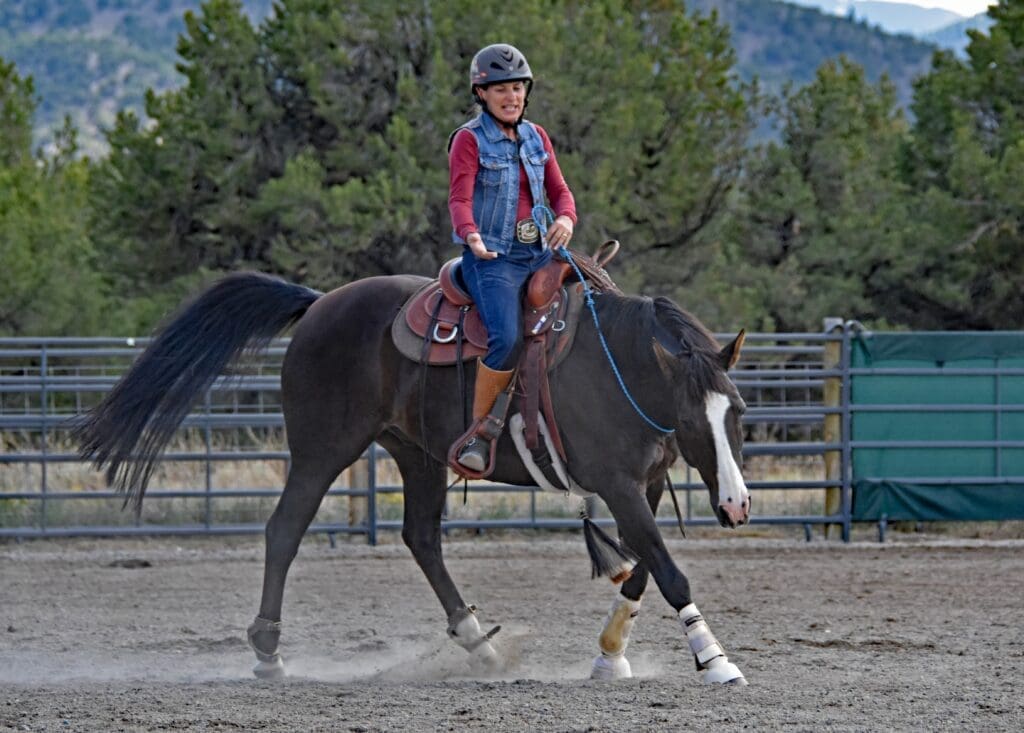
Turning with natural aids
As some of you know, I’ve been developing a new curriculum for my online training program, focusing on entry-level dressage. This program is designed for both English and Western riders who aspire to deepen their riding skills, enhance communication with their horse, and potentially participate at in-person or virtual dressage competitions. A core philosophy underpinning this new curriculum, and indeed all effective horse training, is the power of breaking down large goals into small, achievable baby steps.
In the world of horse training, there’s an old adage: “The slower you go, the faster you get there”. This isn’t just about patience; it’s about the strategic importance of building a solid foundation. Rushing through the early stages of training or attempting advanced maneuvers before a horse is truly prepared can lead to resistance, nervousness, and agitation. Conversely, taking the time to establish these foundational layers ensures much smoother and quicker progression to higher-level skills. This is true for both horse and rider.
A surprising number of riders aspire to learn more about classical riding, what we know of today as dressage. It’s a lofty goal, and this foundational knowledge will serve you well in any equestrian endeavor. My new syllabus starts with the big goal—to ride an entry-level dressage test. That test involves, basic movements at the walk & trot exhibiting clear transitions with rhythm.
As I break the lesson plans down, there are literally dozens of “chapters” from evaluating tack and conformation, to testing your horse’s responsiveness to your aids, all the way to bending, collection, and lateral movements. Each “chapter” entails another dozen or so lessons, or steps to accomplish. Breaking the goal down into its smallest components is the key to success.
At the heart of this “baby steps” approach is the concept that “all of training occurs in transitions”. A transition happens any time you ask your horse to speed up or slow down. By practicing transitions at specific markers in your arena, you refine your cues and understand your horse’s preparation and response time, building consistency and responsiveness.
Another vital “baby step” is shifting from an over-reliance on the reins to communicating with your horse through your natural aids: seat, legs, arms, and voice. Many riders, due to ingrained muscle memory, default to pulling on the reins first when asking for a change. However, horses are highly motivated to listen to subtle seat and leg cues if they learn that responding means less bit pressure. It’s crucial to understand that reins are not for cueing, but for reinforcement to a cue that came from your other aids.
Consider a complex movement like collection. This is a significant achievement, defined as a shortening and rounding of the horse’s frame to transfer weight from his forehand to his hindquarters, thus enhancing power, coordination, and athleticism. True collection is not achieved by pulling on the horse’s mouth. Instead, it’s built upon preparatory skills such as moving freely forward in all three gaits off light aids, bending, and teaching the horse to give to the lightest bit pressure and seek out slack. It takes substantial time and conditioning for the horse to develop the necessary musculature for sustained collection.
This month’s featured video clip, “The Anatomy of a Turn: Riding Corners and Straight Lines,” perfectly illustrates the power of focusing on one small step at a time and is one of maybe a hundred baby steps in the dressage curriculum. The exercise of riding squares or 90-degree turns followed by straight lines breaks down the seemingly simple act of turning a corner into a precise maneuver. It teaches your horse to follow your body cues—your eyes, shoulders, and torso—rather than relying on bit pressure alone.
This is a crucial step in breaking the “reins-first” habit, which is foundational for more advanced communication. Mastering this seemingly small exercise significantly improves your horse’s balance by encouraging them to elevate their inside shoulder in the turn, laying essential groundwork for future complex movements.
Embrace the journey of horsemanship one step at a time. By mastering these foundational elements, you’ll unlock extraordinary progress and a deeper connection with your equine partner.
The Anatomy of a Turn: riding corners and straight lines

